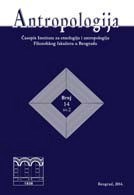МУСЛИМАНСКО СТАНОВНИШТВО БЕОГРАДА У 18. ВЕКУ
The Muslim population of Belgrade in the 18th century
Author(s): Miroslav Pavlović, Ognjen Ž. KrešićSubject(s): Political history, 18th Century, The Ottoman Empire, History of Islam
Published by: Институт за етнологију и антропологију
Keywords: Ottoman Empire; 18th century; Ottoman elite; Sanjak of Smederevo; Belgrade; population; asker
Summary/Abstract: The Age of ayans, a name often given to the 18th century period of the history of the European part of the Ottoman Empire, is a period of decentralization and deterioration of the military system inherited from the classical period. Development of Belgrade in this age was marked by the Austrian rule between 1718 and 1739, when the oriental outlook of the city was lost. After the reincorporation of the Sancak of Semendire into the Ottoman Empire, the orientalization of Belgrade became one of the prerequisites for the functioning of the city life. The rebuilding of the city took up most of the second half of the century, and it encompassed the reconstruction both of military fortifications, and of the religious endowments, communal buildings and private houses. The political and social changes left their mark on the population of Belgrade. Organization of local administration attracted various jobless and landless adventures to become part of the city garrison in the fortress and to enter the service of Belgrade’s viziers. An important source of new population were sipahis and janissaries, members of military orders that lost much of their military function, who came to the city seeking opportunities for additional income. Some of them opened taverns or worked as artisans, and others got involved into tax farming (iltizam system). Representatives of powerful merchant families of Rumeli and Istanbul moved there in order to enmesh themselves into the profitable mercantile network of Balkan merchants (Greeks, Armenians, Serbs, Jews, etc.) on the main route from Thessaloniki to Belgrade and further to the Habsburg Monarchy. The basic official sources from the 18th century – tax registers (defter-i hakani, tapu tahrir defteri), attest that more than 2000 adult Muslim men lived in the city in 1741. It is supposed that the population steadily increased until the end of the century. This period also saw the ever greater divisions between different social groups and a start of proto-political conflicts and organized opposition to the ruling structures. The 18th-century Belgrade was by the dynamics of its development a place of contact between two empires. It was an oriental town that was undergoing quick and substantial changes and at the same time it acquired foundations for the future modernization. Belgrade remained a predominantly Muslim town until the incursion of the troops of Osman Pazvanoğlu that gave an impetus to the organization of an uprising by the local Serbian population. These events started a fundamental change of the character of the city in the 19th century.
Journal: Antropologija
- Issue Year: 19/2019
- Issue No: 3
- Page Range: 15-38
- Page Count: 24
- Language: Serbian

